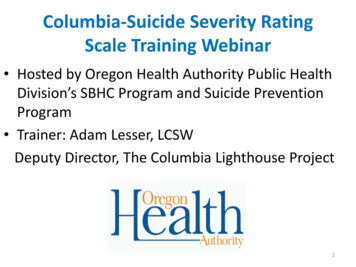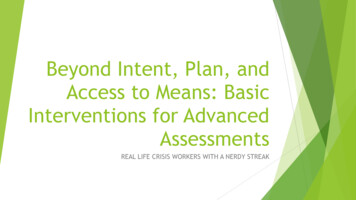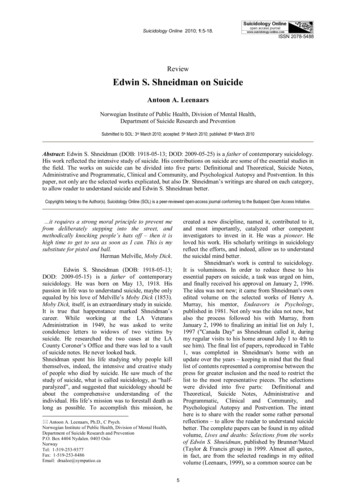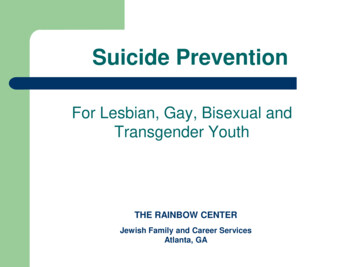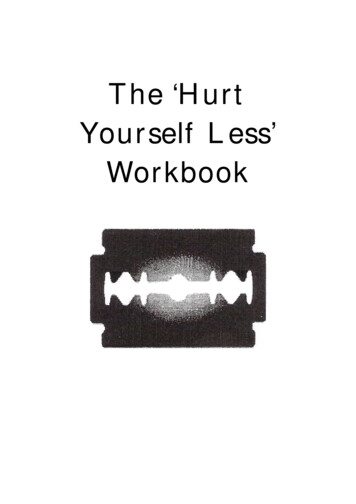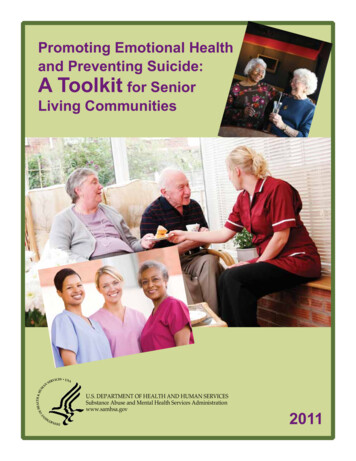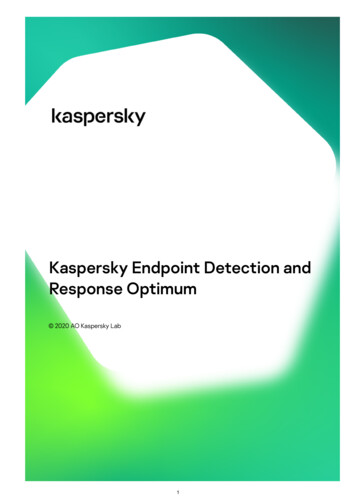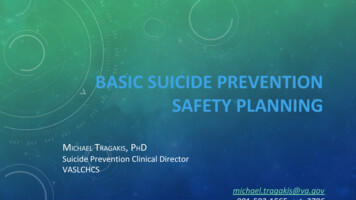
Transcription
BASIC SUICIDE PREVENTIONSAFETY PLANNINGMICHAEL TRAGAKIS, PHDSuicide Prevention Clinical DirectorVASLCHCSmichael.tragakis@va.gov
This breakout is intended to build skills and confidence insupporting someone at risk of suicide, using a safety planningintervention to increase safety and manage suicidal distress.Objectives:1. Understand the benefits of/research behind safety planning2. Learn about the components of safety planning3. Be able to create a robust, useful safety plan
OVERVIEW Research behind Suicide Prevention Safety Planning Overview of the plan and process Additional focus on: Lethal means reduction Reasons for living
THE PROBLEM OF FOLLOW-UP ANDFOLLOW-THROUGH About 420,000 individuals a year present at EDs for suicidality Suicide risk remains high for at least six months following an EDvisit and is increased for those who present at EDs Nearly HALF of suicidal ED patients do no attend outpatienttreatment or drop out quickly
TREATMENT ASUSUAL
WHAT IS SAFETY PLANNING? In the words of one of the originators of the Suicide PreventionSafety Plan Intervention, Dr. Barbara Stanley: Its a clear and detailed, step-by-step, emergency response plan Aimed at keeping suicidal individuals safe until CBT can be delivered orpharmacotherapy can take effect Suicidality is known to ebb and flow -- when a suicidal person can stave offsuicidal urges, the urges can dissipate https://www.youtube.com/watch?v f4dYmWxAK Q
SAFETY PLANNING SAVES LIVESCOMPARED TO NO-SUICIDE CONTRACTS: Stanley, Brown, Brenner, et al (2018) Individuals who safety planned in the ED were half as likely to exhibit suicidal behavior and twice as likely topresent for outpatient MH appointments Zonana, Simberlund & Christos (2018) Safety plans reduce suicidal behavior, increase crisis call use and decrease hospitalizations Gamarra, Luciano, Gradus, et al (2015) Veterans with higher quality safety plans are less likely to be hospitalized in the year after safety planning
CRAIG BRYAN, PSYD AT NCVS WITH MILITARYSAMPLES Bryan, Mintz, Clemans, et al. (2017) – Impact on SI & behavior Both attempts and ideation were reduced for those with safety plans as compared to CFS (Contract for Safety) Bryan, Mintz, Clemans, et al. (2018) – Impact on mood and hospitalizations Safety Planning linked to reductions in negative and increases in positive emotions Enhanced safety planning (i.e., includes Reasons for Living) was linked to a decrease in psychiatric hospitalization Bryan, May, Rozek, et al (2018) – Those who made and used safety plans were more likely to recallbehavioral coping strategies and less likely to be hospitalized
GIVING CREDIT WHERE CREDIT IS DUE The evidence-base for suicide prevention safety planning has been anchoredby the work of Gregory Brown, PhD & Barbara Stanley, PhD, disseminated atthe VA by Wendy Batdorf, PhD as well as the Rocky Mountain MIRECC SINCERE THANKS for these clinicians training others in suicide preventionsafety planning as an INTERVENTION that can be STANDARDIZED Several of the slides in this presentation are used with permission from the VA AdvancedTraining in the Safety Planning Intervention (ASPI) Program For more information about the ASPI Program, please visit http://suicidesafetyplan.com/ This presentation is not intended to replace or substitute the intensive didactic andexperiential training provided in the ASPI program. Additional competency-based training isrecommended to obtain the necessary skills to implement this intervention. Thispresentation alone does not provide equivalent training to the EBP training programs.
SETTINGTHE STAGERATIONALE,crisis narrative& collaboration
HELP THE CLIENT SEE THE RATIONALE Recognize Avert crisis “How do you think when you are in crisis?” (i.e., fight or flight) Memory/attention? Planning? Impulsivity? Help client see that suicidal/crisis feelings arenot indefinite Symptoms are now personal red flags for action Military metaphors – DRILL and Standard of Practice
IT ALL STARTS WITH A CRISIS NARRATIVE“Would you tell me what you experiencedin your recent crisis, when you were indanger of acting on your suicidal feelings?”
IN THENARRATIVE, LOOK FOR SPECIFIC Thoughts Mind quality (e.g., racing) Images Intense emotions Physical Sensations Behaviors External events Stressors
FROM Brown,Stanley &Batdorf (April2020)
COLLABORATION IS KEY Veteran can feel alone and embarrassed Normalize Offer empathy & support Clinician takes an active approach at each step of the process1.Explains rationale for the step2.Brainstorms ideas with the client but let them offer choices first3.Assesses feasibility and addresses road-blocks Take time out and turn toward the client Pen & paper and then using the computer can help here
THE SAFETYPLAN7 sectionsto Improvedsafety& outlook
SECTIONS OF A SAFETY PLAN1.Triggers/Risk Factors/Warning signs2.Internal Coping Strategies3.Social contacts & Settings to Distract4.Family or friends who can help5.Professionals/VCL6.Making the environment safe7.Reasons for Living
QUALITY & COMPLETENESS Remember the notion of S.M.A.R.T. goalswhen making safety plans More detail is better: Identified coping strategies Specific support people Making sure listed telephone numbers and addresses are current Takes about 20-30 minutes
EASY TO READ & EASY TO FOLLOW Use the patients own words Hand-written works well Index cards Safety plan templates Guide Veteran to follow the steps until suicidal crisis subsides If one section is not helpful, go to the next step Remind that they can certainly reach out for support at any time Use VIEW PURPOSE & TIPs suggestions throughout the template
STEP 1:TRIGGERS, RISK FACTORS AND WARNING SIGNS RATIONALE – Signs and symptoms become a cue to use the Safety Plan Identify specific thoughts, images, emotions, physical sensations, or behaviors May need to refer to CRISIS NARRATIVE Internal experience is more useful than external! If Veteran mentions an external trigger, follow-up by asking how the respond
SPECIFIC EXAMPLES OF WARNING SIGNS Thoughts: “I feel worthless.” “I feel like a burden to my family.” “It’s hopeless; things won’t change orget better.” “There is no way out other than to kill myself.” Mind quality: Having racing thoughts, thinking about many problems with no conclusions Intense Emotions: Feeling very depressed, anxious, angry, shame. Physical Sensations: not sleeping, loss of appetite, Behaviors: Isolating self, pacing, giving things away, crying a lot, drinking more than usual
STEP 2:INTERNAL COPING STRATEGIES RATIONALE – Ways to get one’s mind off the crisis situation to let emotions settle These are things one can do to distract without anyone around (the “3am rule) Go beyond everyday activities and common coping strategies Guide Veterans away when they want to rely on family/partners here Virtual Hope Box app & www.dbtselfhelp.com can be helpful resources NOTE: Disputing negative thoughts noted n the “warning signs” section is not usually possible in crisis Do not endorse distracting activities that are likely to increase suicide risk such as “having a few drinks,” “sharpeningknives,” “cleaning my firearms,” etc.
LET’S PRACTICEInternal Coping Strategies listed: Video games Call a buddy Listen to music Watch comedy Go outsideHOW CAN WE IMPROVE THESE?
STEP 3:SUPPORTIVE CONTACTS WHO MAY DISTRACT FROMTHE CRISIS RATIONALE – Identifying individuals who can provide distraction can further mitigate a crisis Use these supports if internal coping strategies aren’t helping Don’t get bogged down if the Veteran doesn’t want to list specific people, though try to get as specificas the will allow Can list by nicknames May also indicate “Veteran describes a lack of social contacts”
PUBLIC PLACES TO TAKE THE MIND OFF CRISIS Specific places should be identified rather than vague places: Such as coffee shops, malls, churches, clubs, support groups, 12-step meetings, Vet Center Be sure that the identified person or place does not increase suicide risk, such as going to the bar, as wellas places the Veteran will actually go Also, places that are readily accessible and frequently available are best. Social activities that require advanced planning are not typically helpful here. WITH EACH SECTION – Assess feasibility and address obstacles
STEP 4:FAMILY OR FRIENDS WHO MAY OFFER HELP RATIONALE – When the crisis mounts, we need supportive others who can help keep us safe or get usto safety Be sure to distinguish distractors from safety sources If s/he is willing, have the Veteran look up and write actual telephone numbers (rather than, “They’re inmy phone.”) It is okay to leave this section blank after discussion, but you must select one or both items at thebottom of this section, stating that: Veteran describes a lack of family or friends Veteran chooses not to disclose distress to friends or family.
USE THIS STEP AS A SPRING BOARD FOR ADDITIONALINTERVENTION FOR THOSE WHO HAVE SUPPORTS – Encourage them to share the safety plan with trusted others FOR THOSE WITHOUT SUPPORTS – Brainstorm ways for them to increase the level of social support: PRRC Vet Center 12-step groups NAMI Social skills training
STEP 5:PROFESSIONALS & AGENCIES TO CONTACT FOR HELP RATIONALE – This section provides ready access to the ways to contact professionals/services to reachout to if previous steps did not resolve the crisis. This section should not be left blank; if the Veteran does not name any other professional contacts, listyourself as a provider to contact, if appropriate to your role. List the numbers in the order the Veteran would call them.
STEP 6:MAKING THE ENVIRONMENT SAFE RATIONALE – Reducing access to all lethal means can help keep a Veteran safe in a moment of crisis Collaborate with Veteran to find acceptable, voluntary options that reduce access to those means and makethe environment safer. Gun safety/safe storage rather than gun restriction Motivational interviewing principles (e.g., tying to other goals, weighing pros/cons, increasing change talk)and a Veteran-centric approach will be helpful here If goal is self-protection, discuss other potential ways to protect self/family May involve trusted family and friends to help with barriers
QUESTIONS TO ASK What items in your environment might you use to hurtyourself? These may include weapons, firearms, drugs, medications, household toxins, alcohol or other potentiallylethal items. If the Veteran has a plan for suicide, be sure to explore access to the means for that plan. What can we do to make the environment safer? Discuss safe storage of firearms (e.g., gun locks, gun safes, storing ammunition away from firearms) Medication safety involves medication lock boxes, smaller amounts in the home, relying on family forstorage/dispensation, opiate education & naloxone
VIDEO DEMONSTRATION Dr. Craig Bryan - Firearm Safety Counseling:https://www.youtube.com/watch?v -GSo1np LUY&list PL18STxWYFOZsj0ZLXAsYvSF8qwrNuTXnZ&index 7
FACTORS THAT WILL IMPACT YOUR APPROACH INREDUCING LETHAL MEANS Urgency of the situation Your relationship to the Veteran Your comfort with firearms or other means Veteran’s reason for having access to lethal means
BE SURE TO ADD – STEP 7: REASONS FOR LIVING Research (e.g., Bakhiyi, Calati, Guillaume, et al, 2016; Bryan, Oakey & Harris,2018) indicates that reasons for living are negatively correlated with suicidalthinking and behavior Brief Reasons for Living Inventory (Cwik, Siegmann, Willutzki, et al, 2017) has sixsubscales: Fear of suicide, responsibility to family, survival and coping beliefs, child-related concerns,moral objections, and fear of social disapproval Desire to learn or experience something, family-related or otherwise) ASK: What are people, goals, beliefs or experiences that would be importantto remind you of in moments of crisis to give you a will to live?
NEXTSTEPSWrapping up the planUsing AppsAdditional Training
WRAPPING UP THE PLAN Review the plan with the Veteran and assess how likely s/he is to useit Problem-solve barriers to using the plan Assign homework? (e.g., using a particular strategy; adding more to the plan) Discuss where the Veteran will keep the plan MILLENIAL HACK - Take a pic of the plan Make sure the Veteran gets a copy Set a date to review the plan
TRAINING VIDEOS FROM DR. CRAIG BRYAN WITH THENATIONAL CENTER FOR VETERAN’S STUDIES Introducing a Safety plan to a client:https://www.youtube.com/watch?v KqYMqaB9kzg&list PL18STxWYFOZsj0ZLXAsYvSF8qwrNuTXnZ&index 5 Firearm Safety Counseling:https://www.youtube.com/watch?v -GSo1np LUY&list PL18STxWYFOZsj0ZLXAsYvSF8qwrNuTXnZ&index 7
TAKE-HOME MESSAGES Safety planning is an evidence-based intervention that saves lives The best plans are actionable, in the Veteran’s own words, andconstantly being updated Clinicians set the tone for the utility of safety plans Reducing access to lethal means and reasons for living are essentialcomponents of safety planningIF YOU ONLY HAVE TIME FOR ONE INTERVENTIONMAKE A SAFETY PLAN!
REFERENCESBarbara Stanley, PhD1,2; Gregory K. Brown, PhD3; Lisa A. Brenner, PhD4,5; Hanga C. Galfalvy, PhD1,2; Glenn W. Currier, MD6; KerryL. Knox, PhD7,8; Sadia R. Chaudhury, PhD1,2; Ashley L. Bush, MMA3; Kelly L. Green, PhD3 Comparison of the Safety PlanningIntervention With Follow-up vs Usual Care of Suicidal Patients Treated in the Emergency Department JAMAPsychiatry. 2018;75(9):894-900. doi:10.1001/jamapsychiatry.2018.1776Ting SA, Sullivan AF, Boudreaux ED, Miller I, Camargo CA Jr. Trends in US emergency department visits for attempted suicideand self-inflicted injury, 1993-2008. Gen Hosp Psychiatry. 2012;34(5):557-565. doi:10.1016/j.genhosppsych.2012.03.020The Joint Commission. Sentinel Event Alert 56: Detecting and treating suicide ideation in all settings2016; https://www.jointcommission.org/assets/1/18/SEA 56 Suicide.pdf. Accessed March 11, 2017.Stanley B, Chaudhury SR, Chesin M, et al. An emergency department intervention and follow-up to reduce suicide risk in theVA: acceptability and effectiveness. Psychiatr Serv. 2016;67(6):680-683. ossrefChesin MS, Stanley B, Haigh EA, et al. Staff views of an emergency department intervention using safety planning andstructured follow-up with suicidal veterans. Arch Suicide Res. 2017;21(1):127-137. doi:10.1080/13811118.2016.1164642
REFERENCES (continued)Jennifer M. Gamarra, B.A.1,2, Matthew T. Luciano, B.A.1,4, Jaimie L. Gradus, D.Sc., M.P.H.1,2,3, and Shannon Wiltsey Stirman,Ph.D. Assessing variability and implementation fidelity of suicide prevention safety planning in a regional VA HealthcareSystem Crisis. 2015 November ; 36(6): 433–439. doi:10.1027/0227-5910/a000345CJ Bryan, J Mintz, TA Clemans, TS Burch, et al, (2018 ) Effect of crisis response planning on patient mood and cliniciandecision making: A clinical trial with suicidal US soldiers. Psychiatric Services; 69 (1)https://doi.org/10.1176/appi.ps.201700157CJ Bryan, AM May, DC Rozek, et al (2018). Use of crisis management interventions among suicidal patients: Results of arandomized controlled trial. Depression & Anxiety, 35 (7). https://doi.org/10.1002/da.22753Zonana, J., Simberlund, J., & Christos, P. (2018). The impact of safety plans in an outpatient clinic. Crisis: The Journal of CrisisIntervention and Suicide Prevention, 39(4), 304–309. https://doi.org/10.1027/0227-5910/a000495CL Bakhiyi, R Calati, S Guillaume, P Courtet, et al (2016). Do reasons for living protect against suicidal thoughts andbehaviors? A systematic review of the literature. Journal of Psychiatric Research, 9
BASIC SUICIDE PREVENTION SAFETY PLANNING MICHAEL TRAGAKIS, PHD Suicide Prevention Clinical Directo
